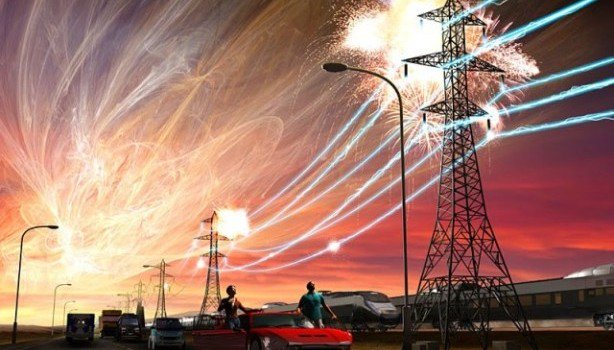The sun, the giver of life on Earth, can also be a furious adversary. Powerful eruptions on the sun’s surface send intense bursts of charged particles and electromagnetic radiation hurtling through space. When these solar storms hit Earth, they can induce enormous electrical currents in the planet’s upper atmosphere and within the very infrastructure we rely upon – the electricity grid. Let’s take a deeper look at this invisible yet formidable threat.
A Destructive History
While solar storms have occurred for eons, our modern interconnected world leaves us uniquely exposed. The most famous event is the Carrington Event of 1859, when intense auroras stretched as far as Cuba and unprecedentedly bright light filled the night sky. But the true devastation was the collapse of telegraph systems across the United States and Europe from induced currents burning out wires and shocking operators. A storm of that magnitude today could have catastrophic consequences.
In 1989, a massive solar eruption triggered the complete blackout of Quebec’s power grid for over 9 hours. Nearly 6 million people lost power as geomagnetically induced currents (GICs) flowed through the ground and into transmission lines, ultimately leading to the failure of the system’s static VAR compensators and tripping of protective relays. Key transformers overheated to the point of permanent damage.
These “one-off” events provide hints of the potential devastation if multiple utilities were compromised simultaneously. With aging grid infrastructure like 40-60 year old transformers, the lights could go dark for months or years across vast regions if irreparable damage occurred.

The Impact of Solar Storms
Solar storms stem from highly complex magnetic phenomena playing out on the surface of the sun. Regions of intense magnetic flux known as sunspots can explosively realign, ejecting billions of tons of ionized matter (plasma) into space in events called coronal mass ejections (CMEs). If one of these CMEs is aimed at Earth, its radiation and charged particles can reach us in a few days.
As the solar plasma strikes the magnetosphere, it distorts and strengthens Earth’s magnetic field lines near the poles. Intense electrical currents build up in the upper atmosphere where the air is more rarified. These currents couple to long-distance transmission lines, entering the power grid and flowing along the path of least resistance through grounded transformers. This overwhelming geomagnetically induced current can lead to half-cycle saturation of the transformer cores, producing stray electromagnetic fields that heat up and permanently damage copper windings.

The Gathering Storm
Solar activity waxes and wanes on a roughly 11-year cycle, alternating between periods of increased storms and relative calm. Worryingly, we are now exiting a decade-long solar minimum and entering a new period of heightened turbulence. The upcoming solar maximum from 2024-2026 is projected to be one of the strongest in 50+ years based on early indicators.
So how prepared is our grid for the coming tempest? The outlook is concerning, as infrastructure expenditures take time to implement across thousands of utilities. New resilient transformer designs phasing in GIC-reducing grounds and installing blocking devices provide incrementally better tolerance. But with the bulk of capital investment in the grid focused on reliability rather than solar storm hardening, the margin for absorbing an extreme event remains narrow.

A Brighter Future?
Moving forward, grid operators aim to install new monitoring networks to provide early warning detection of incoming solar plasma. Machine learning algorithms are being developed to better predict CME trajectories and impacts, hopefully allowing for preemptive load-shifting or temporary grid reconfigurations. Government programs like the Space Weather Operations to Newly Enhanced Backup Utility Redundancy (SONAR) initiative are exploring portable back-up transformers and responsive islanding procedures.
At the research stage, breakthroughs in materials like amorphous metallic glass composites and high-temperature superconductors could one day usher in transformers inherently immune to GIC saturation and overheating. Utilities are also evaluating high-altitude ballooning of transmission lines and underground cabling to reduce atmospheric coupling of solar particles.
Ultimately, while the risks are severe, investments in monitoring, resilient equipment, and operational procedures can help blunt solar storms’ impact on the grid. By better understanding and preparing for this cosmic threat, we can ensure the lights stay on – both day and night.




